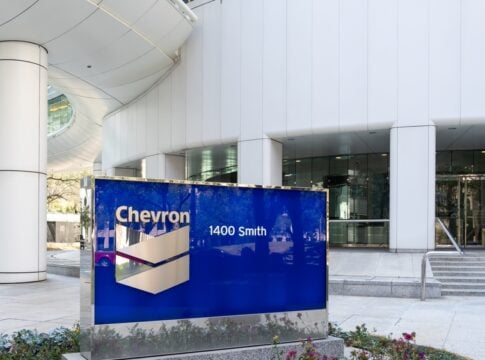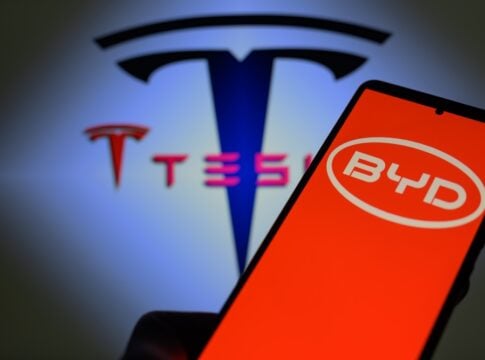DevvStream Holdings Inc., a publicly traded carbon management and technology company, has taken a bold step into the world of digital assets. The company announced it will use $10 million from its first financing round to buy digital currencies like Bitcoin and Solana. This strategy helps DevvStream’s long-term goal. It aims to use blockchain tech to digitize and grow the global carbon credit market.
The funds come from the first tranche of a much larger $300 million convertible note facility, provided by Helena Partners. DevvStream plans to speed up the growth of tokenized carbon credit systems. They will do this while keeping share dilution low for existing investors. This latest development positions DevvStream at the intersection of sustainability, finance, and technology.
Building a Blockchain Treasury: Why Bitcoin and Solana?
DevvStream’s newly launched crypto treasury will include Bitcoin (BTC), Solana (SOL), and the company’s own DevvE token. Each digital asset plays a different role in the company’s overall strategy.
- Bitcoin
Bitcoin is being used as a reserve asset. This cryptocurrency is known for its limited supply and wide use. This gives DevvStream a stable and liquid foundation. Its role in the treasury is to provide long-term value. It also acts as a financial cushion, separate from traditional markets.
- Solana
Solana, on the other hand, is being used for its technical utility. Known for fast transaction speeds and low fees, Solana’s blockchain provides the flexibility DevvStream needs to power smart contracts and digital token systems. It will play a central role in enabling the real-time creation, exchange, and settlement of tokenized carbon credits.
- DevvE
Finally, DevvE—the company’s native utility token—will serve as the bridge between environmental assets and blockchain infrastructure. DevvStream plans to use DevvE to create financial tools. These tools will help trade, monitor, and verify carbon credits and other sustainability assets on the blockchain.
These digital assets give DevvStream a varied crypto base. In turn, this base helps ensure financial security and supports platform functionality. The company noted:
“This $300 million facility allows us to improve capital efficiency, reduce dilution, and bring global investors into the carbon ecosystem through a digital gateway. The combination of crypto reserves and real-world asset tokenization represents the next evolution of our capital strategy.”
Tokenizing Carbon Credits and Real-World Environmental Assets
At the core of DevvStream’s strategy is the tokenization of carbon credits and related environmental assets. Tokenization turns real-world assets, like a certified carbon offset or a clean energy project, into digital tokens. These tokens can be issued, traded, and tracked on a blockchain.
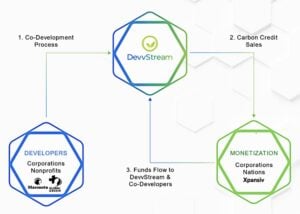
This move is designed to bring transparency, liquidity, and speed to carbon markets, which are criticized for being slow, opaque, and fragmented. DevvStream thinks that by tokenizing these credits, it can help investors. This will improve access, ensure quality and traceability, and lower transaction costs.
The company is not only focused on carbon credits. It is also looking into tokenizing renewable energy infrastructure. This includes solar farms and battery storage systems.
These real-world assets could turn into digital investment products. This change could create new ways to finance clean energy development.
With this, DevvStream is not just making digital currencies; it is also building a new model for sustainable finance. This model links environmental impact with digital market infrastructure.
Trust and Tech: Safeguarding the Digital Green Future
DevvStream has chosen a regulated digital asset custodian. This helps them manage their crypto treasury safely and professionally. It has also partnered with a digital asset adviser to oversee treasury operations and ensure compliance with financial and regulatory standards.
DevvStream’s approach shows it is dedicated to building a strong and secure base for its digital finance strategy. It also helps build trust with investors and partners who may still be cautious about cryptocurrency exposure.
The company’s stock responded positively to the announcement. Shares jumped after the news. This shows that investors trust DevvStream’s plan to mix sustainability with blockchain innovation.
The treasury allocation is just the beginning. DevvStream will use more funds from the $300 million facility. They plan to boost their blockchain capabilities, support new sustainability projects, and launch their full token platform worldwide.

A Glimpse Into the Future Where Climate Goals Meet Crypto Gains
DevvStream’s decision to combine carbon management with digital assets reflects a growing trend in climate finance. More companies see how blockchain can fix old problems in the carbon market. These issues include double counting, poor transparency, and limited access.
As a result, the voluntary carbon market, though valued at around $4 billion in 2024, still operates far below its potential.
The issue of double counting alone may affect up to 30–40% of reported GHG reductions, undermining trust in climate claims. Also, carbon markets are often broken up, unclear, and depend on many brokers and registries.
Blockchain solves these issues with features like:
-
Tamper-proof tracking
-
Real-time updates
-
Automated credit retirement
-
Tokenizing real-world assets, such as carbon offsets
These systems make it easier to trace the origin and ownership of each credit, reduce fraud, and lower transaction costs. They expand access by allowing fractional ownership. This allows more people and companies to take part.
The market for blockchain carbon credit certification is growing fast. It could jump from about $884 million–$1.06 billion by 2030.

By combining carbon management with digital assets, DevvStream is tapping into this momentum—helping build a more open, liquid, and trustworthy carbon credit market.
A Digital Pathway to Real Climate Impact
With blockchain, each token can carry data about the origin, verification, and impact of a carbon credit. Investors can see where their money goes and what environmental results it supports. This level of clarity is difficult to achieve in traditional markets but becomes possible with digital tools.
In the long run, this approach could allow sustainability projects—from reforestation efforts to clean transportation systems—to raise capital faster, more efficiently, and with full transparency. It also helps align financial returns with climate goals, providing a win-win for investors and the planet.
DevvStream’s $10 million investment in Bitcoin, Solana, and its own token isn’t just about treasury management. It shows the future direction of sustainable finance.
The company is using digital assets and blockchain. This creates a platform for carbon credits and environmental projects, where they can work quickly, reliably, and openly. With this strategic move, DevvStream is not just participating in the future of clean finance. It is helping to define it.
The post DevvStream Bets $10M on Bitcoin and Solana to Reinvent Carbon Credit Markets appeared first on Carbon Credits.
Carbon Footprint
ChatGPT Hits 700M Weekly Users, But at What Environmental Cost?
OpenAI confirmed that ChatGPT now attracts 700 million weekly active users, up from around 500 million users in March. ChatGPT has grown four times compared to last year, showing a quick growth in both consumer and business areas.
The surge includes users from free, Plus, Pro, Enterprise, Team, and educational plans. This demonstrates broad AI adoption among individuals, businesses, and schools.
ChatGPT Soars Past 700 Million Weekly Active Users
ChatGPT is one of the fastest-growing online platforms ever. Its natural language skills, wide range of functions, and global workflow integration fuel this growth.
OpenAI’s official figures show ChatGPT’s user base quadrupled in less than a year, as the platform expanded voice, coding, and data tools. This huge growth matches the rising interest in AI tools.
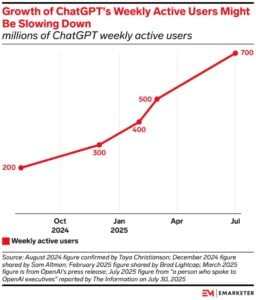
There is a growing demand for virtual assistants. Also, machine learning is being used more in business, education, and media.
The rise of ChatGPT brings not just innovation but also environmental responsibility into focus. As artificial intelligence grows, so does the need for electricity, cooling, and computing power. This raises key questions about carbon emissions, energy use, and water consumption.
ChatGPT’s Environmental Footprint: Carbon, Energy, and Water Use
Let’s look closely at each of these footprints to grasp the chatbot’s environmental impact.
-
Carbon Emissions from AI Queries: Emissions per Prompt
Each time a user enters a prompt into ChatGPT, servers housed in large data centers activate to generate a response. While a single query might seem harmless, the emissions can add up quickly when repeated millions—or billions—of times a week.
Recent research shows that each ChatGPT query consumes about 0.3 to 0.4 watt-hours of electricity. Depending on the energy source powering the data center, this results in around 0.15 grams of CO₂ per response.
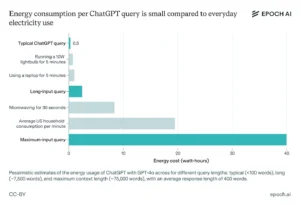
That’s less than the footprint of a Google search but still meaningful when scaled up. Multiply it by millions of daily queries, and it equates to hundreds of thousands of kilograms of CO₂ emissions per month.
One estimate says ChatGPT might release over 260,000 kilograms of CO₂ each month. That’s like the emissions from 260 round-trip flights between New York and London. This amount would increase even more if users shift to longer or more complex prompts, which require more processing time and energy.
-
The Energy Hunger of AI
Energy use is at the core of ChatGPT’s footprint. OpenAI uses powerful servers equipped with GPUs (graphics processing units) or AI accelerators like those from NVIDIA. These systems require large amounts of electricity for both computation and cooling.
To support ChatGPT’s scale—700 million weekly users—OpenAI may be operating thousands of servers running 24/7. Estimates show that daily inference needs more than 340 megawatt-hours (MWh) of electricity. That’s about the same as what 30,000 U.S. homes use in a day.
And that’s just for inference. The training phase of large language models (LLMs) like GPT-3 or GPT-4 uses even more energy.
- Training GPT-3 used 1,287 megawatt-hours of energy. This caused about 550 metric tons of CO₂ emissions. That’s like a car driving 1.2 million miles.
Training newer, larger models—like GPT-4 and beyond—will likely require even more energy. Emissions depend on the energy mix, like renewables versus fossil fuels. Even in the best cases, high-performance computing still uses a lot of energy.
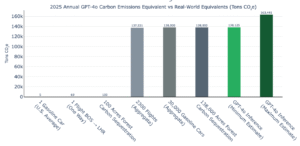
-
Water Usage for AI Cooling
One lesser-known but equally important resource consumed by ChatGPT is water. Data centers use water to cool hot-running servers, often in combination with air conditioning. Water either evaporates in cooling towers or comes from nearby freshwater sources. It is then released at higher temperatures.
A study estimates that every 20 to 50 queries to ChatGPT uses about half a liter of water. Most of this water is for cooling the hardware that processes those responses. That means even a casual user engaging with ChatGPT 10 times a day may indirectly use several liters of water per week.
The impact magnifies when considering model training. Training large AI models has used millions of liters of water. This is especially true in dry areas where cooling systems rely more on water than air.
Globally, the AI industry is expected to draw 4.2 to 6.6 billion cubic meters of water per year by 2027 if growth continues at the current pace. That’s equal to the annual water use of several million households.
Prompts, Processors & Power Grids: What Makes AI Greener?
Several factors influence how large or small ChatGPT’s environmental footprint becomes:
Prompt length and complexity:
A short sentence uses far less energy than a long essay or technical code. Complex prompts need more processing power, which raises energy use and emissions. A recent report shows they can use up to 50 times more energy per query.
Model size and efficiency:
GPT-4 and newer models are larger and more powerful than previous versions, but also more energy hungry. Smaller models like GPT-3.5 or distilled versions use less energy. They are great for simple tasks.
Data center location and power source:
Using renewable-powered data centers in cooler climates reduces both carbon and water footprints. Conversely, data centers relying on coal or natural gas contribute more to emissions.
Cooling methods:
Facilities that rely on advanced air-cooling or closed-loop water systems tend to have lower water footprints than traditional open cooling towers.
Here’s a glance at the chatbot’s environmental footprint:
ChatGPT Environmental Footprint
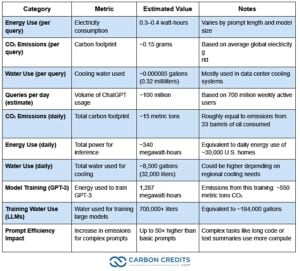
Industry Response: Moving Toward Sustainable AI
OpenAI and other AI leaders are increasingly aware of their environmental responsibilities. Many companies have committed to using renewable energy for data center operations.
Some companies are using carbon offset programs. They are also investing in energy-efficient chips from NVIDIA and AMD, which lower the power needed for each AI query.
Cloud service providers—such as Microsoft (a key OpenAI partner), Google, and Amazon—have all pledged to run their operations on 100% renewable energy by the end of the decade. Some already claim carbon neutrality for select cloud regions, although these claims often rely on offsets.
AI developers are also exploring ways to improve model efficiency, reducing the number of computations needed to produce high-quality responses. This helps not only lower costs but also shrink carbon and water footprints.
Users, too, have a role to play. The community can help lessen the environmental impact of tools like ChatGPT. They can do this by using better prompts, avoiding extra questions, and supporting companies that focus on green AI.
Navigating ChatGPT Use and Sustainability
Clearly, ChatGPT supports billions of interactions with minimal per-query footprint, yet scale causes cumulative environmental impact. Experts now call for more sustainable AI practices, such as:
- Choose concise prompts to reduce processing time and energy.
- Use smaller, more efficient models when possible.
- Developers should deploy energy-efficient hardware and renewable-powered data centers.
- Companies like OpenAI, Google, and Microsoft aim for carbon-neutral operations. However, changing supply chains and inference grid sources is also key.
Some studies point out that certain types of AI prompts—especially long or complex ones—can use up to 50 times more energy than simpler requests. That means user behavior significantly affects environmental costs, making user education part of the solution.
Reducing the carbon and water footprint of ChatGPT is not just an operational concern. It is important for public trust, business use, and following regulations. This is especially true in areas focused on ESG standards.
As ChatGPT’s weekly active users approach 700 million, the opportunity—and responsibility—for sustainable scaling grows. OpenAI should balance bigger server pools and improved models with efficiency.
The post ChatGPT Hits 700M Weekly Users, But at What Environmental Cost? appeared first on Carbon Credits.
Carbon Footprint
Chevron (CVX Stock) Powers Through Q2 With $5.5B Payout, Permian Growth, and Net-Zero Push
Chevron (NYSE: CVX) delivered better-than-expected earnings in the second quarter of 2025 despite falling oil prices and weaker refining margins. Profits fell year-over-year. However, strong production in the Permian Basin and careful capital management allowed the company to generate solid cash flow. This also helped maintain returns for shareholders.
Alongside its financial results, Chevron reaffirmed its climate goals. This includes net-zero Scope 1 and 2 emissions by 2050. It also involves ongoing investments in carbon capture, hydrogen, and renewable fuels. These efforts support a wider energy transition strategy.
Chevron’s Q2 Delivers Amid Oil Price Drops
Chevron Corporation shared its financial results for the second quarter of 2025. The results show pressure from lower oil prices but also show progress in its long-term strategy.
For the quarter ending June 30, 2025, the company posted net income of $2.49 billion, or $1.45 per share. After adjusting for special items, earnings came in at $1.77 per share, slightly higher than what Wall Street expected.
Total revenue came in at $44.82 billion, a decline of about 12% compared to the same quarter last year. This marks Chevron’s lowest quarterly profit in four years, largely due to weaker oil prices and refining margins.

Even so, the company’s earnings still exceeded analyst expectations on an adjusted basis.
Chevron’s earnings followed a similar trend seen across the oil and gas sector. Other major energy firms also reported lower profits, driven by high production levels and flat global demand.
In particular, weaker natural gas prices and reduced margins in fuels and chemicals impacted Chevron’s bottom line.
Strong Oil Production and Cash Flow Help Offset Weak Prices
Despite the decline in profits, Chevron maintained a strong operating performance. The company increased production in the Permian Basin, reaching over 1 million barrels of oil equivalent per day. This is the highest output the company has reported from that region since mid-2024.
Chevron generated $4.9 billion in free cash flow during the quarter, a 15% increase compared to the first quarter of the year. The company also returned $5.5 billion to shareholders through a mix of dividends and share buybacks.
Notably, Chevron continued its stock buyback program temporarily in the second quarter. The oil major’s ongoing efforts to acquire Hess Corporation will boost its access to oil reserves in Guyana.
Overall, Chevron’s operational strength and disciplined capital management helped it weather the effects of falling oil prices.
- INTERESTING READ: Big Oil’s Showdown: How Shell, Chevron & ExxonMobil Balance Big Profits with Net Zero?
Cleaner Barrels Ahead: Chevron’s Climate and Net Zero Plan
Chevron continues to work toward reducing its greenhouse gas emissions while meeting global energy demand. The company has a long-term goal of reaching net-zero emissions for its upstream Scope 1 and Scope 2 operations by 2050.
Scope 1 includes direct emissions from Chevron’s operations. Scope 2 covers indirect emissions from electricity and heat that Chevron buys.
Chevron measures emissions with a full value chain approach. This includes Scope 3 emissions. These emissions cover the use of sold products, such as gasoline and diesel. Although the company has not committed to a full Scope 3 net-zero goal, it reports these figures for transparency and to track progress.
In addition to these goals, Chevron has introduced a carbon intensity reduction target, aiming to cut emissions per unit of energy produced. The company’s target is to reduce its Portfolio Carbon Intensity by more than 5% by 2028, using a 2022 baseline.
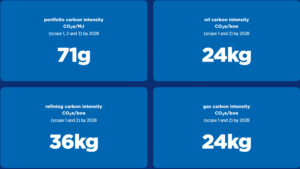
Chevron’s reported greenhouse gas (GHG) emissions for 2024 are approximately:
-
Scope 1: 53 to 54 million tonnes CO2 equivalent (Mt CO2e)
-
Scope 2 (market-based indirect emissions): about 3 to 4 million tonnes CO2e
-
Scope 3 (mainly from use of sold products): between 416 million and 717 million tonnes CO2e, depending on calculation method (production, throughput, or sales method).
Chevron’s portfolio carbon intensity is at around 70.7 grams CO2e per megajoule energy produced. The oil giant’s upstream carbon intensity is about 23.9 kg CO2e per barrel of oil equivalent.
Investing in Lower-Carbon Solutions
Beyond reducing emissions from its own operations, Chevron is building a portfolio of low-carbon businesses. The company is investing in carbon capture and storage (CCS), hydrogen, and renewable fuels.
According to its 2024 Corporate Sustainability Highlights, Chevron invested over $600 million in over 100 emissions abatement projects in 2024, which will grow to $1.5 billion this year. These projects aim to cut around 1.2 million tonnes of CO2 equivalent each year. These include:
-
methane emission reductions through facility retrofits,
-
electrification of natural gas compression stations, and
-
efficiency improvements at refineries and LNG plants.
Moreover, Chevron has invested over $1 billion in carbon capture and storage projects. These efforts aim to cut emissions by around 5 million tonnes of CO2 each year. The company is growing its range of abatement technologies and low-carbon investments. This shows a big increase from previous years.
These efforts aim to reduce the company’s upstream carbon intensity to around 24 kilograms of CO₂ equivalent per barrel of oil. Chevron’s decarbonization plan includes energy efficiency upgrades, equipment changes, and the use of renewable electricity at production sites.
Chevron has partnerships with multiple firms focused on carbon removal, including projects that store CO₂ underground or use advanced technologies to capture emissions at industrial sites. These investments are intended to grow over time as demand for clean energy increases.
The company is also looking into hydrogen storage solutions. It has also invested early in fusion energy technologies. These ventures are still in development but represent Chevron’s effort to stay ahead of long-term changes in the energy system.
Chevron’s total planned investment in low-carbon businesses is projected to reach $10 billion through 2028. The company has made it clear that it wants to be part of the energy transition, even while continuing to supply traditional oil and gas.
Eyes on 2026: Risks, Rewards, and What’s Next for Chevron
Still, Chevron faces criticism from some investors and environmental groups. Concerns include how fast things are changing. There’s also a need for total emissions cuts, not just reducing intensity.
Plus, the company keeps investing in oil and gas production. Chevron responds by saying it must balance energy reliability, affordability, and sustainability. It also supports carbon markets, carbon pricing, and efforts to scale up verified carbon credits.
Though the amount or figure wasn’t disclosed, Chevron has bought millions of carbon credits. Between 2022 and 2024, Chevron’s Colombian subsidiary purchased around 3 million carbon credits. These credits support Indigenous community conservation projects in the Colombian Amazon through the REDD+ program.
Chevron also bought 1.8 million carbon credits from the Cotuhé Putumayo project. This purchase helped offset regional emissions. These credits mainly reflect avoided deforestation and conservation efforts.
Chevron believes oil and gas will remain important for decades. Their strategy focuses on cutting emissions from this supply. At the same time, they are developing new energy solutions.
The company’s Q2 results show the pressure facing oil producers in a lower-price environment. Even though revenue and profits fell from last year, Chevron posted solid operating results.
Whether Chevron can meet its 2050 net-zero goals while maintaining shareholder value and energy supply will depend on policy changes, market demand, and technological progress. But for now, the company is signaling that it plans to be part of both today’s energy system and tomorrow’s clean energy transition.
The post Chevron (CVX Stock) Powers Through Q2 With $5.5B Payout, Permian Growth, and Net-Zero Push appeared first on Carbon Credits.
Carbon Footprint
BYD (BYDDY) Beats Tesla (TSLA) in Europe: The EV Shift No One Saw Coming
Tesla’s (TSLA) dominance in Europe is fading fast. In July 2025, its sales in France plunged nearly 27%—one of its steepest monthly declines yet. Once an EV frontrunner, Tesla is now clearly struggling to keep up. Chinese competitors like BYD (BYDDY) are racing ahead, and local automakers are also pushing back hard.
What once felt like unstoppable momentum, Musk’s Tesla has turned into a scramble to retain market share. Europe’s EV market is now the most competitive in the world, and Tesla is feeling the heat.
A CNBC report highlighted that,
“Data published by the U.K.’s Society of Motor Manufacturers and Traders (SMMT) showed Tesla’s new car sales dropped by nearly 60% to 987 units last month, down from 2,462 a year ago.”
Tesla’s European Market Share Continues to Shrink
According to the European Automobile Manufacturers Association, Tesla’s market share in the EU, U.K., and EFTA dropped to 2.8% in June, down from 3.4% the previous year.
The company sold 34,781 vehicles across the region that month, which is a 22.9% year-on-year drop. Also in July, its sales in France plunged by nearly 27%, marking one of its steepest monthly drops yet.
The above data tells that Tesla is facing severe headwinds across Europe, with sales falling in most major markets despite the launch of an updated Model Y. According to Reuters, Tesla’s new car registrations in:
-
Sweden fell 86%
-
Denmark dropped 52%
-
Netherlands sank 62%
-
Belgium declined 58%
-
Italy slipped 5%
-
Portugal slid 49%
The only bright spots were Norway and Spain, where Tesla saw gains of 83% and 27%, respectively. Norway’s spike followed the rollout of 0% interest loans on Tesla models, while Spain’s surge coincided with a 155% jump in sales of all electrified cars.
The chart below also tells us that Tesla is losing ground in Europe.
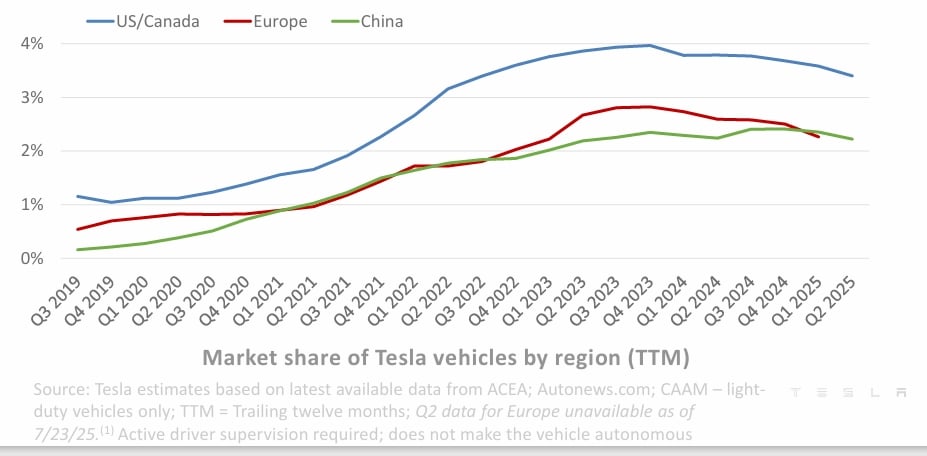
Model Y Revamp Fails to Lift Sales
Tesla had pinned hopes on its refreshed Model Y, which began selling in March 2025 in Europe. However, the update has failed to spark meaningful growth. According to analyst Felipe Munoz from JATO Dynamics, the updated Model Y “has so far failed to provide the expected sales boost.”
Even in Tesla-stronghold Sweden, Model Y registrations fell 88% in July. In Denmark, they dropped 49%. By contrast, Norway saw a resurgence, with Model Y registrations jumping fourfold to 715 units due to financing incentives.
Here’s how Tesla (TSLA) performed in Q2 2025.

- SEE DETAILS: TSLA Stock Drops on Weak Q2 2025 Earnings: Tesla Faces Carbon Credit, Margin, and Political Risks
Pricing Strategy and Margins Under Pressure
To stay competitive, Tesla has slashed prices across Europe, often undercutting its margins. In France, the company’s market share fell from 1.6% in 2024 to just 0.9% in 2025, with buyers turning to local brands like Renault, which outsold Tesla’s Model Y with its new Renault 5 model in June.
Aggressive discounting might stimulate demand in the short term, but it signals waning pricing power, a worrying trend for a brand that once commanded premium status.
Tight Rules Stall Tesla’s Self-Driving Push in Europe
Another pain point for Tesla in Europe is the region’s strict autonomous driving regulations. While Tesla’s supervised self-driving feature is a major selling point in the U.S., it’s not fully available in many European countries due to tighter rules.
Musk acknowledged in July that the company could have “a few rough quarters” ahead as it waits for approvals and ramps up production of a new, more affordable EV model.
Tesla’s efforts to diversify include a trial robotaxi service in Austin, Texas, using autonomous Model Y vehicles. However, this program is not yet authorized for widespread deployment in Europe.
BYD Steals the Spotlight in Major European Markets
While Tesla stumbled, Chinese EV giant BYD roared ahead. In Spain, BYD sold 2,158 cars in July, nearly 8X more than the same month last year.
- In the UK, BYD registered 3,184 vehicles, quadrupling its year-over-year numbers. And in Germany, BYD posted a 390% increase in July sales.
BYD’s affordability, growing dealership network, and product variety have helped it attract European buyers seeking alternatives to Tesla.
- Notably, BYD overtook Tesla in overall European EV sales as early as April 2025, a trend that now looks firmly established.
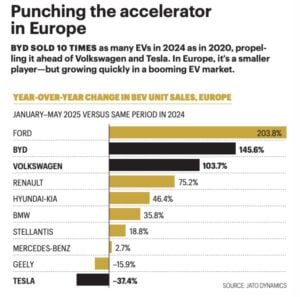
Smart Pricing, Sharp Growth
BYD’s strategy of affordable pricing and rapid expansion is paying off. Models like the Dolphin Surf (globally known as the Seagull) and the Seal U are leading the charge. The Seal U tied as Europe’s best-selling PHEV in June.
Looking ahead, BYD plans to expand into 12 more European countries by the end of 2025. The company is also preparing to launch local production in Hungary, helping it reduce costs, navigate EU tariffs, and better compete with local and global rivals.
Chinese Brands Make Their Mark
The impact goes beyond BYD. Chinese EV makers, led by BYD, have nearly doubled their collective market share in Europe — from 2.7% in early 2024 to 5.1% in the first half of 2025. This surge reflects the growing influence of Chinese automakers across the European auto market.
Broader EV Market Still Growing—But Tesla Lags Behind
It’s important to note that Tesla’s slump comes at a time when overall EV demand in Europe is still rising. In July:
-
Denmark’s overall car sales rose 20%
-
Sweden was up 6%
-
Norway surged 48%
-
Spain grew 17%
-
Portugal jumped 21%
This makes Tesla’s performance look even worse in comparison. The EV pioneer is not suffering from market decline, but rather losing ground to faster-moving rivals like BYD, Volkswagen, and Renault.
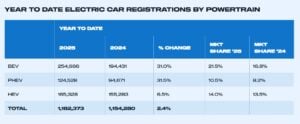
Elon Musk’s Controversies Add Fuel to the Fire
Aside from market dynamics, Tesla is battling reputational damage, much of it tied to CEO Elon Musk. His endorsement of Germany’s far-right AfD party and anti-union comments sparked protests at Tesla showrooms across Europe.
The backlash has been especially strong in Germany, where labor unions and political parties wield significant influence. Tesla’s sales in the country dropped 55% in July, with only 1,110 units sold compared to 2,469 a year ago. From January to July, Tesla’s total German sales plunged 57.8% to just 10,000 units.
In Britain, Tesla’s July sales fell 60%, while BYD’s more than quadrupled.
Legacy Automakers Also Feel the Heat
Tesla isn’t the only automaker feeling the squeeze. European giants like Volkswagen, BMW, Mercedes-Benz, Stellantis, and Renault all posted weak Q2 results, citing falling demand and concerns over U.S. import tariffs.
However, these companies are still expanding their EV offerings and investing in local supply chains, unlike Tesla, which continues to rely heavily on exports and centralized production.
What Lies Ahead?
Tesla’s roadmap includes a more affordable EV model and the potential expansion of its Berlin Gigafactory’s output. But until production ramps up and autonomous features are approved in Europe, Tesla may continue to struggle.
In contrast, BYD and other Chinese players are gaining speed, price advantage, and regulatory momentum, making them serious threats to Tesla’s European ambitions.
Tesla’s 27% sales crash in France shows that the much-touted EV leader is on the defensive in a region once crucial to its global strategy. Concisely, unless Tesla adjusts its pricing, updates its lineup more frequently, and repairs its brand reputation, it may continue to lose ground to BYD and others.
The post BYD (BYDDY) Beats Tesla (TSLA) in Europe: The EV Shift No One Saw Coming appeared first on Carbon Credits.
-
Climate Change2 years ago
Spanish-language misinformation on renewable energy spreads online, report shows
-
Climate Change Videos2 years ago
The toxic gas flares fuelling Nigeria’s climate change – BBC News
-

 Greenhouse Gases1 year ago
Greenhouse Gases1 year ago嘉宾来稿:满足中国增长的用电需求 光伏加储能“比新建煤电更实惠”
-

 Climate Change1 year ago
Climate Change1 year ago嘉宾来稿:满足中国增长的用电需求 光伏加储能“比新建煤电更实惠”
-

 Carbon Footprint1 year ago
Carbon Footprint1 year agoUS SEC’s Climate Disclosure Rules Spur Renewed Interest in Carbon Credits
-
Climate Change2 years ago
Why airlines are perfect targets for anti-greenwashing legal action
-
Climate Change Videos2 years ago
The toxic gas flares fuelling Nigeria’s climate change – BBC News
-
Climate Change2 years ago
Some firms unaware of England’s new single-use plastic ban



